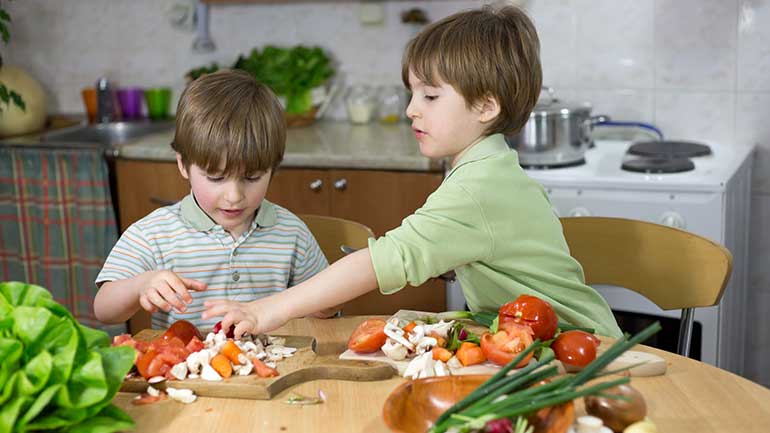
Simple ways to educate and support a new vegan to eat a balanced and healthy diet.
Vegan and whole food plant based diets are increasingly mainstream. Celebrities such as Taylor Swift and Beyoncé have proudly declared they are going vegan, encouraging some children and youth to follow suit. Some young people are motivated to eat this way for ethical or political reasons, such as the desire to do no harm to an animal or to preserve the environment. Your child’s friends might also have adopted a vegan diet. But is a vegan or plant-based diet a healthy option for a growing child? Read on for simple ways to educate and support a new vegan to eat a balanced and healthy diet in order to meet all their nutritional needs.
What are vegan and whole food plant based diets like?
A vegan diet is a type of vegetarian diet. A person following a vegan diet will avoid eating all animal protein including meat, poultry, fish and seafood, all dairy products and eggs, and may also avoid food that contains animal ingredients, such as honey. In the U.S., the Academy of Nutrition and Dietetics has long recognized that appropriately planned vegan diets are healthy and can meet peoples’ nutritional needs regardless of their age or stage in life. In fact, long term studies have shown plant-based vegan diets may actually reduce the risk of a person developing heart disease or type II diabetes.
A whole foods plant based diet involves avoiding all animal products and any refined foods, such as white rice, white bread and vegetable oils. The focus of this eating pattern is on the health benefits of eating whole plant foods: whole grains (brown rice, millet, wheat berries), legumes (lentils, peas and beans), nuts, vegetables and fruits.
How do I help my child plan a health vegan or whole foods plant based diet?
A vegan diet requires more discipline in both you and your child. It takes more than simply eliminating meat. Depending on their age, you will need to involve them in planning their own diet so that they will know what they need to eat at home, and what they can eat away from home. Both of you will benefit from discussing the extra steps required to take on this change, and if both of you are ready to take this on. It would also be wise to ask your child why they want to go this route and for how long.
Here are four simple steps to help your child or family go vegan or plant based:
- Talk with your child. Listen to your child explain what they know about veganism as well as their motivation for choosing to eat this way. Making this lifestyle change is challenging: Shopping, cooking and eating out all will involve changes but your understanding and support will help smooth their transition. Reassure your child that you will explore and learn about veganism with them and find sound information so that they can be healthy.
- Do your research. Read reputable vegan resources to help you and your child become informed. Seek out credible books written by dietitians, such as “Becoming Vegan” by Brenda Davis RD and Vesanto Melina, RD or “Cooking Vegetarian” by Vesanto Melina, RD and Joseph Forest. Check out blogs written by dietitians such as Becomingvegan.ca or Plantbaseddietitian.com to ensure you get expert information from professionals trained to counsel people on their diets. You can also call HealthLink BC at 8-1-1 or email them, for free nutrition advice from a registered dietitian.
-
Keep cooking simple to start. Choose combinations that involve a whole grain, beans, vegetables and a sauce for main dishes. For example, brown rice, chickpeas, green and red peppers and a sesame seed sauce. Asian, Mexican or Mediterranean cuisines all have vegetarian dishes that can be easily converted to become vegan. Try:
- Asian dish: Whole wheat noodles, firm tofu, Chinese broccoli with a black bean sauce.
- Mediterranean dish: Quinoa, lentils, roasted vegetables and kale with a tomato sauce.
- Mexican dish: Brown rice and bean burrito, lettuce, tomatoes, cucumbers with salsa.
-
Give a fortified soy beverage – A fortified soy beverage is the best choice for those who do not drink cow’s milk because it contains calcium, and vitamins D and B12. For a nutritious breakfast, try overnight oats with walnuts, blueberries and fortified soy milk.
-
Speak to a dietitian about supplements – Depending on your child’s age, and what they eat, they make need to take a supplement(s) to get enough of the vitamins and minerals they need for healthy growth and development. Nutrients that may need supplementing are iron, calcium and vitamins D and B12. You can reach a dietitian (free of charge) at HealthLinkBC Dietitian Services by calling 8-1-1 or sending an email.
These tips should help you and your family go vibrantly vegan and power up with plant foods for optimal health.
Learn more about healthy eating for children and children and vegetarian diets.
